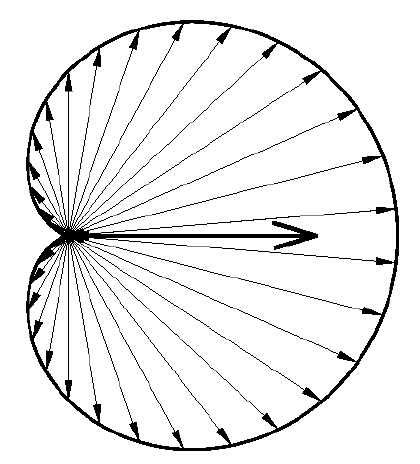
The figure above shows the probability of the positron resulting from a muon decay emerging at different directions with respect to the muon-spin direction (which is shown by the large horizontal arrow).
1. What is a muon?
A muon is a spin-1/2 particle. A particle physicist would think of a positive muon as a lepton, a heavy anti-electron. That of course is what it really is.

The figure above shows the probability of the positron resulting from a muon decay emerging at different directions with respect to the muon-spin direction (which is shown by the large horizontal arrow).
This technique is known as 
2.  SR
SR
 which stands
for MUON SPIN ROTATION. We perform this technique on a number of different
types of organic materials, including:
which stands
for MUON SPIN ROTATION. We perform this technique on a number of different
types of organic materials, including:
 SR is not
a diffraction technique. Muons are fired at the sample, and almost instantaneously
implant at particular (typically interstitial) sites. They stay there until
they die, although in some materials, at certain temperatures, muon diffusion
is observed.
SR is not
a diffraction technique. Muons are fired at the sample, and almost instantaneously
implant at particular (typically interstitial) sites. They stay there until
they die, although in some materials, at certain temperatures, muon diffusion
is observed.
The  SR experiments
are performed at the ISIS Pulsed
Muon Facility at the Rutherford Appleton Laboratory (close to Oxford)
and also at the Paul Scherrer
Institute, near Zürich in Switzerland.
SR experiments
are performed at the ISIS Pulsed
Muon Facility at the Rutherford Appleton Laboratory (close to Oxford)
and also at the Paul Scherrer
Institute, near Zürich in Switzerland.
3. What does it tell us?
 SR gives direct
information about local magnetic fields, making the technique very useful
for studying magnetic materials and superconductors.
SR gives direct
information about local magnetic fields, making the technique very useful
for studying magnetic materials and superconductors.
It can be especially useful because (a) it is a local probe of internal fields, (b) it can be used to follow an order parameter as a function of temperature, (c) it works very well at milli-Kelvin temperatures (the incident muons easily pass through the dilution refrigerator windows), (d) it provides information on antiferromagnets, spin-gap systems, spin glasses as well as on ferromagnets, (e) if there are a range of muon sites it can provide information about internal magnetic field distributions and (f) it provides information about magnetic fluctuations and spin dynamics, even above the magnetic transition temperature.
![]()
This occurs because  SR
also measures spin relaxation (the muon-spin can be influenced by dynamical
fluctuations of the local magnetic field). Thus an initially spin-polarized
muon beam can depolarize due to this fluctuating local field distribution.
SR
also measures spin relaxation (the muon-spin can be influenced by dynamical
fluctuations of the local magnetic field). Thus an initially spin-polarized
muon beam can depolarize due to this fluctuating local field distribution.
 SR is very effective
in studying the field distribution inside superconductors. For example
the technique has been applied by us and colleagues in St Andrew's and
Birmingham to the charge-transfer salt
SR is very effective
in studying the field distribution inside superconductors. For example
the technique has been applied by us and colleagues in St Andrew's and
Birmingham to the charge-transfer salt  -(BEDT-TTF)
-(BEDT-TTF) Cu(NCS)
Cu(NCS) (
( 10.4 K). The width
of the field distribution,
10.4 K). The width
of the field distribution,  in an applied transverse magnetic field yields the penetration
depth
in an applied transverse magnetic field yields the penetration
depth  and
hence the superconducting carrier density
and
hence the superconducting carrier density  .
For more details on this topic see Physical Review Letters 79, 1563
(1997).
.
For more details on this topic see Physical Review Letters 79, 1563
(1997).
The technique can also be used to obtain dynamical information through the anisotropy of the electron-nuclear hyperfine interaction.
Conducting polymers are currently being developed intensively for many technological applications based on their novel electronic and optical properties. A good understanding of the charge transport mechanisms in such systems is of fundamental importance. Muon spin relaxation techniques have been developed to probe the highly anisotropic motion of the polaronic charge carriers in these polymers. Further details
For reviews of  SR, see the following articles:
SR, see the following articles:
Further information can also be found on the ISIS Pulsed Muon Facility home page.